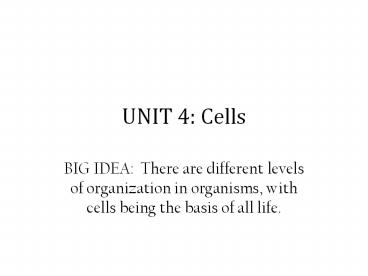UNIT 4: Cells - PowerPoint PPT Presentation
1 / 20
Title:
UNIT 4: Cells
Description:
UNIT 4: Cells BIG IDEA: There are different levels of organization in organisms, with cells being the basis of all life. Cell Theory Timeline What is a cell? – PowerPoint PPT presentation
Number of Views:124
Avg rating:3.0/5.0
Title: UNIT 4: Cells
1
UNIT 4 Cells
- BIG IDEA There are different levels of
organization in organisms, with cells being the
basis of all life.
2
Cell Theory Timeline
3
What is a cell?
- The basic unit of structure and function of life.
4
1665 Robert Hooke
- Builds compound microscopes and first to observe
cork cells.
5
Late1600s Anton van Leeuwenhoek
- Builds simple, powerful microscopes and 1st to
see living cells - Observes blood cells, animal sperm cells,
bacteria from his own teeth! He called them
animalcules
6
Cell Theory
- The observations about cells from the past 150
years is becoming more organized in the 1800s - Schleiden, Schwann and Virchow are the scientists
who contribute to developing a unifying cell
theory
7
- 1838 Matthias Schleiden Concludes all plants
are made of cells - 1839 Theodor Schwann Concludes all animals are
made of cells.
8
- 1855 Virchow
- Concludes that all cells come from pre-existing
cells
9
Cell Theory
- All organisms are composed of one or more cells.
- Cells are the basic units of structure and
function in an organism. - Cells come only from the reproduction of existing
cells.
10
Cell Diversity
- Shape There are many cell shapes. The function
of the cell influences the shape of the cell. - Size Different types of cells have different
sizes. - 0.1 µm 100 µm
- The size of a cell is limited by the surface
area-to volume ratio.
11
(No Transcript)
12
Surface area-to-volume Ratio
larger
- As the cell gets ______, the surface-area-to-volum
e ratio gets _________. - If the cell grows beyond a certain limit, not
enough material will be able to cross the
membrane fast enough to provide for the increased
volume.
smaller
13
Surface area-to-volume ratio
Length of side Surface Area Volume Surface Area/ Volume
1
2
4
6
1
6
8
3
24
96
64
3/2 1.5
14
Surface area-to-volume ratio
- Materials must enter through the surface.
- The bigger the cell, the smaller the surface
area-to-volume ratio. - If a cell is too large, there is not enough
surface area to allow materials to pass through
quickly enough.
15
Types of Cells
- Prokaryotic vs. Eukaryotic
16
Prokaryotic Cells
17
- Very simple cell
- Generally smaller
- NO membrane-bound organelles (compartments)
- No true nucleus.
- DNA is found in the nucleoid region and is NOT
separated by a membrane. - Example is bacteria.
18
Eukaryotic Cell
19
- More complex cells
- Generally bigger
- Contains membrane-bound organelles
- Has a true nucleus
- Region of where DNA is stored and is separated by
a membrane. - Examples are animals plants
20
Pop Quiz!
- Who is credited for first seeing cells?
- According to the Cell Theory, where do all cells
come from? - Which cells are simpler Prokaryotic or
Eukaryotic? - Which cells contain membrane-bound organelles?
- Which type of cells do you have?































